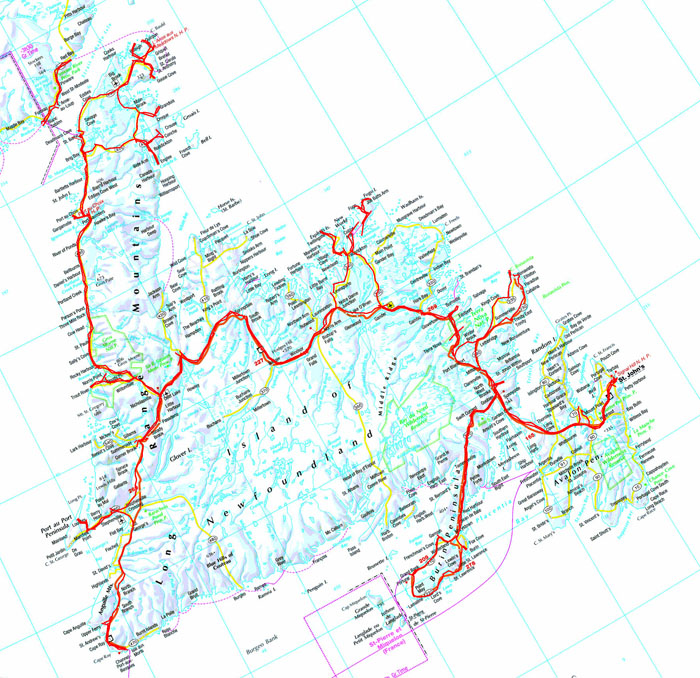
|
Terre-Neuve est une ile au large du Labrador dont elle est séparée par le détroit de Belle-Isle et à l’entrée du Golfe du St Laurent. Ainsi la côte-ouest est baignée par le St Laurent et les côtes nord et est par l’océan Atlantique. Elle est sous l’influence climatique des vents froids de l’arctique descendant par le Labrador et des vents chauds du Gulf Stream par l’Atlantique. De plus la côte-est est longée par l’Iceberg Alley descendant du Groenland. La côte-est est la plus spectaculaire, découpée par de nombreux fjords, péninsules donnant des paysages sublimes. Sa superficie est d’environ 112.000 km² pour une population inférieure à 500.000 habitants. Le centre de l’ile est quasiment inhabité, la population de pêcheurs est localisée sur le littoral. Elle fut habitée par des paléo indiens depuis +9.000ans. Les Beothuks disparurent par les conflits armés ainsi que par les maladies apportées par les européens. Pour l’histoire de sa colonisation nous renvoyons le lecteur à Wikipédia. Je visitais Terre-Neuve du 2 mai au 20 juin. Ce n’est pas la saison touristique car le froid et la neige étaient encore présents et les activités pour la plupart fermées. Selon les Tourist-Informations ainsi que les habitants la meilleur période serait de mi-juillet à mi-août avec de belles journées en septembre et même en octobre. De plus le réchauffement climatique se fait sentir par des hivers moins rigoureux. Personnellement j’ai adoré Terre-Neuve pour plusieurs raisons. La plus importante est la conséquence d’avoir été hors saison sans touriste polluant les paysages et les curiosités ouvertes et, encombrant les routes. De plus je pouvais bivouaquer n’importe où sans être inquiété par les riverains où par les autorités mandatées. Malgré le froid et les intempéries j’ai pu faire des promenades dans les parcs ouverts regrettant le Gros Morne NP. Mais c’était un choix. La nature sauvage est splendide sachant que la forêt a été et est encore l’objet d’une surexploitation. J’ai vu des orignaux, des oiseaux ainsi que des puffins. J’ai effectué trois escapades, au Labrador, à Fogo Island et à St Pierre et Miquelon, bien sûr mon cœur a surtout été ému par cette dernière. J’ai parcouru environ 5.000 kilomètres en 50 jours soit une moyenne de 100 km/jour. Les 1.000 km de retour à Port aux Basques peuvent être évités en juillet en prenant le ferry d'Argentia à North-Sydney.
Newfoundland is an island off Labrador from which it is separated by the
strait of Belle-Isle and at the entrance of Gulf of St Lawrence. Thus it
west-coast is bathed by St Lawrence and the north and east coasts by the
Atlantic Ocean. It is under the climatic influence of the cold winds
from the Arctic going down by Labrador and the hot winds from the Gulf
Stream by the Atlantic. Moreover east-coast it is skirted by the Iceberg
Alley going down from Greenland. East-Coast most spectacular, is cut out
by many fjords, peninsulas giving dramatic landscapes. Its surface is
about 112,000 km² for a population lower than 500,000 inhabitants. The
center of the island is almost uninhabited, the population of fishermen
is localized on the littoral. It was inhabited by paleo Indian since
+9.000ans. Beothuks disappeared by the armed conflicts as by the
diseases brought by Europeans. For the history of its colonization we
return the reader to Wikipedia. I visited Newfoundland from May 2nd to
June 20th. It is not the tourist season because the cold and snow were
still present and the closed activities for the majority. According to
Tourist-Information as well as inhabitants the best the period would be
from mid-July to mid-August with beautiful days in September and even in
October. Moreover climate warming is felt by less rigorous winters.
Personally I adored Newfoundland for several reasons. The most important
is to have been consequence except season without tourist polluting
landscapes and open curiosities and, encumbering the roads. Moreover I
could bivouac anywhere without being worried by the residents or by the
elected authorities. In spite of the cold and the bad weather I could
take walks in the open parks regretting Gros Morne NP. But it was a
choice. Wilderness nature is splendid knowing that the forest was and is
still the object of an overexploitation. I saw moose's, birds as well as
puffins. I carried out three escapades, in Labrador, in Fogo Island and
in St Pierre et Miquelon, of course my heart was especially moved by the
latter. I traversed approximately 5,000 kilometers in 50 days is an
average of 100 km/day. The 1,000 km back to Port aux Basques can be
avoided in July by taking a ferry from Argentia to North-Sydney.